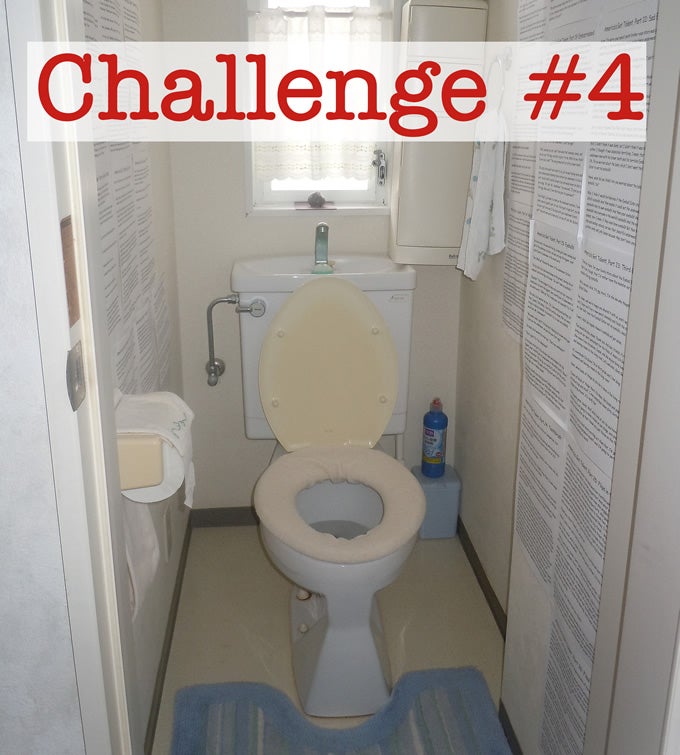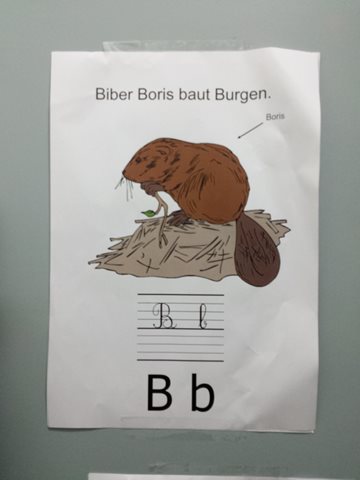Challenge #4: Make Use of Captive Reading
Oct 6, 2014 13:40:51 GMT 9
Post by Adam Beck on Oct 6, 2014 13:40:51 GMT 9

Yes, this is our bathroom. (Don't worry, I'm not challenging you to come over and clean it or anything. Also, please note that we do have a bathtub, but in Japanese homes, bathtubs and toilets are always in separate locations.)
I'm giving you this privileged glimpse of our bathroom to show the "captive reading" papers on the walls (and door, too). In this case, I was writing a "serial story" for my kids.
If you're not familiar with the strategy I call "captive reading," it's basically a way to increase exposure to the minority language--even in your absence--by posting suitable text in the bathroom (or other "captive reading" location), where children with some reading ability will be "forced" to read it. It's simply human nature for our eyes to begin reading any comprehensible text that falls under our gaze and this approach takes crafty advantage of that "automatic reading response."
I've used the idea of captive reading for years, ever since my kids were small, and in a wide variety of forms--persistently adding fresh text to the bathroom door every other day or so. Alongside my other efforts, I believe this practice has had a hugely positive impact on their literacy development and overall ability in the minority language.
At my blog, I've written extensively about my adventures with captive reading, and these are the articles to date, in the order I published them...
What Is Captive Reading and How Will It Help My Bilingual Child?
Don't Read These Words!
Why You Must Put a Whiteboard in the Bathroom
Turn Your Kids into Eager Readers with This Fun, Simple Strategy
How Rats in the Bathroom Can Boost a Child’s Bilingual Ability
If This Isn’t a Big Part of Your Strategy for Raising Bilingual Kids, It Really Should Be
How to Use Poetry with Your Bilingual Kids (And Why You Should)
My Favorite Way to Get a Bilingual Child Reading More in the Minority Language
The Larger Arc of Captive Reading—and Our Lives As Human Beings
For this fourth challenge, I encourage you to consider these posts carefully, as food for thought, then pursue your own sustainable practice of captive reading. (You could start at around age 3.) Which activities would work best for your child's age, language level, and interests?
Experiment for about two weeks then return to this thread and tell us about it! What are you doing? How has your child responded? What sort of impact do you think this might have on her language and literacy development, over time?
Captive reading has been an important "secret weapon" in my own bilingual journey and I urge you to take persistent advantage of this idea, too, to help maximize your child's long-term progress.
P.S. If you're curious to see what sort of "captive reading materials" I'm currently using with my kids (now 10 and 7), just peek inside these two books. I post one mystery on the door every couple of days, which not only promotes reading (and critical thinking), it inspires interaction, too, when they offer their solution to me.
One Minute Mysteries: 65 Short Mysteries You Solve With Science
One Minute Mysteries: 65 More Short Mysteries You Solve With Science





 Some stuff in English and some in Spanish. I am going back to put Spanish stuff on the walls. Like I said before, I did it without knowing it.
Some stuff in English and some in Spanish. I am going back to put Spanish stuff on the walls. Like I said before, I did it without knowing it.








